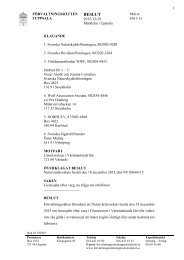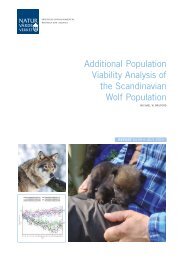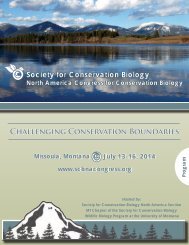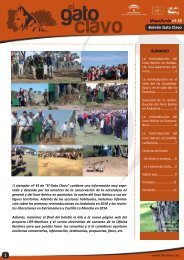1oC3Dbk
1oC3Dbk
1oC3Dbk
Create successful ePaper yourself
Turn your PDF publications into a flip-book with our unique Google optimized e-Paper software.
Earth Watch, Innflow AG, Stämpfli Publikationen AG, and<br />
especially Patrick Meier, Peter Stämpfli, and Jean-Claude and<br />
Annemarie Tschumper.<br />
Dr Christine Breitenmoser and Dr Urs Breitenmoser<br />
Co-chairs, Cat Specialist Group<br />
Caucasus Plant Red List Authority<br />
The mission of the Caucasus Plant RLA is to assess extinction<br />
risk of the Caucasus plants and develop strategies for their<br />
conservation.<br />
The major achievement of the Caucasus Plant RLA in<br />
2013 was publication of the Regional Plant Conservation<br />
Strategy for the Caucasus region Caucasus Plant Initiative by<br />
Missouri Botanical Garden’s Centre for Conservation and<br />
Sustainable Development, in collaboration with BGCI. The<br />
Strategy can be downloaded here. The document was<br />
developed as a result of the project ‘Coordination and<br />
Development of Plant Red List Assessments for the Caucasus<br />
Biodiversity Hotspot’ which was implemented by the IUCN<br />
Species Survival Commission in collaboration with Missouri<br />
Botanical Garden, USA, the WWF Caucasus Programme<br />
Office, and botanists from six countries of the Caucasus<br />
(Armenia, Azerbaijan, Georgia, Iran, Russia, and Turkey) from<br />
2006 to 2010. Targets of the Regional Strategy correspond to<br />
those of the Global Strategy for Plant Conservation (GSPC)<br />
2011–2020. The document illustrates the relevance of the<br />
Caucasus Plant Initiative (CPI) targets to the targets and<br />
actions in the revised and updated Ecoregion Conservation<br />
Plan (ECP) for the Caucasus. Whenever possible, the CPI<br />
should be considered together with ECP in plant conservation<br />
and sustainable use planning.<br />
At present the major output of the above project: Schatz,<br />
G., Shulkina, T. and Solomon, J. (eds.) Red List of the<br />
Endemic Plants of the Caucasus Region; Missouri Botanical<br />
Garden Press, Saint Louis, USA, is in press. Information on<br />
this publication was presented by Prof. Dr George<br />
Nakhutsrishvili at the Plant Life of South West Asia conference<br />
at the Royal Botanic Garden Edinburgh from 1–5 July 2013.<br />
Prof. Dr George Nakhutsrishvilli<br />
Caucasus Plant Red List Authority Coordinator<br />
Cave Invertebrate Specialist Group<br />
Our mission is to stimulate the conservation of all cave<br />
invertebrates, focusing on those not yet covered by other<br />
Specialist Groups such as millipedes, woodlice, springtails,<br />
terrestrial crabs, and spiders which all face very similar threats.<br />
Many of the species covered by the Group are currently<br />
unknown, undescribed, unprotected, and unassessed for The<br />
IUCN Red List. A search of The IUCN Red List 2012 using<br />
‘cave’ as the keyword, ‘Caves and Subterranean Habitats (nonaquatic)’<br />
as the habitat, and ‘Arthropods’ as the taxonomic<br />
group resulted in just 10 species – the number of Critically<br />
Endangered species we predict will be found in single caves.<br />
Being a partially habitat-defined group there is a degree of<br />
overlap with a few existing Specialist Groups but we intend to<br />
make that a positive influence. Our membership is currently<br />
being formed.<br />
Having been established only in December 2013,<br />
comprehensive IUCN Red List assessments will not begin until<br />
2014. However, during the period of its establishment, a ‘living<br />
fossil’ spider (Liphistius kanthan) which is threatened by a<br />
limestone quarry in Malaysia was listed as Critically<br />
Endangered. The IUCN Director General wrote to the CEO of<br />
Lafarge and the Malaysian State Chief Minister, expressing<br />
concern over the threat posed to the spider by their quarrying.<br />
Follow-up has been led by the Co-Chair. As yet, no research in<br />
the context of the Specialist Group has yet been conducted.<br />
A wide range of outreach activities are planned for 2014;<br />
the hash tag #caveinvert has been used on Twitter and will be<br />
used by members tweeting their news.<br />
The Co-chairs have been working together for the<br />
conservation of cave-adapted fauna for nearly two decades,<br />
primarily in SE Asia, Louis from the National Museum of<br />
Natural History, and Tony initially from the World Bank and now<br />
from Fauna and Flora International.<br />
Tony Whitten and Louis Deharveng<br />
Co-chairs, Cave Invertebrate Specialist Group<br />
Cetacean Specialist Group<br />
The mission of the Cetacean Specialist Group (CSG) has long<br />
been and remains to promote and facilitate the conservation of<br />
cetaceans (88 species currently recognized) worldwide. It seeks<br />
Paeonia mlokosewitschii Lomakin. © Sh. Sikharulidze and L. Asieshvili<br />
Kanthan Cave Trapdoor Spider (Liphistius kanthan). © Bjorn Olesen<br />
42 IUCN species Annual Report 2013






